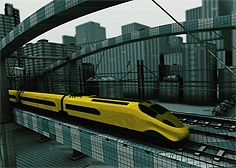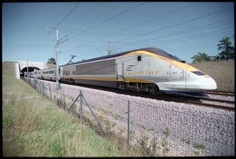Talking exclusively to The Engineer, rail experts from Edinburgh University and Heriot-Watt University have raised concerns over the suitability of existing rail tracks to a new high speed rail network. Their comments come as the Department for Transport launches a white paper detailing plans to expand high speed links in the UK by 2025.
A point can be reached whereby a ground wave starts to develop ahead of the train. The analogy is that of an aircraft going through the sound barrier.
Peter Woodward, Heriot-Watt Univeristy
The report outlines plans for a £60bn Y-shaped route initially linking London with a new station in Birmingham, but later being extended further North with two addditional lines: one serving Manchester, Glasgow and Edinburgh, and the other calling at Sheffield, Leeds and Newcastle. This will add to the existing ’High Speed 1’ Channel Tunnel Rail Link.
As previously reported by The Engineer, many experts have predicted that by 2020 the technology will exist to create a passenger train that can travel up to 400kph (250mph).
Peter Woodward, a reader in Railways and Geotechnical Engineering at Heriot-Watt University, points out these trains will travel on existing track designed for maximum speeds of 125mph.Woodward and his colleague Mike Forde from the Edinburgh University are using computer simulations and a full scale test track to develop guidelines for reinforcing railway so trains can run at higher speeds.

According to Woodward, it is most critical to look at the increasing forces and vibrations induced in the track as a train’s speed picks up. ‘A point can be reached whereby a ground wave starts to develop ahead of the train,’ he said. ‘The analogy is that of an aircraft going through the sound barrier.’
It is possible that if the train was allowed to run at “critical track velocity” it would derail at high speed
Peter Woodward
‘As this point is approached the track will start to undergo strong ground vibrations. This would initially be felt as increased vibration in the train and by vibration being experienced by adjacent properties.’ Woodward said a person looking at the track would observe a ground wave forming in front of the train and propagating with it. ‘It is possible that if the train was allowed to run at this “critical track velocity” the train would derail at high speed,’ he said. ‘It is therefore important that the track is correctly designed and reinforced, if necessary, to ensure that the trains can run safety at high speed and hence the formation of large ground waves prevented.’
The researchers guidelines aim to control ground dynamics. Their suggestions will focus on strengthening soil and reinforcing the gravel railroad bed, or ballast, that trains travel over. Heriot-Watt University is researching the potential of using high performance polymer ‘geocomposites’ for ballasting high-speed track. In addition to ground dynamics, the team will also consider other problems that can occur when a high-speed train transitions on and off bridges.

Mike Forde, from the University of Edinburgh, sees high-speed rail making a significant impact on the UK–especially for travel between Scotland and London. ‘Currently the trains just aren’t fast enough to make it an easy day trip,’ he said. ‘It takes more than four hours each way. It’s just not possible to do a day’s work in London that way. If you were to knock that down to 2.5 hours then you could see trains being more used for commuting this distance.’
While the UK was once a leader in railway technology, it has lagged behind others in terms of high speed systems, Woodward said, because the nation has lacked investment in research and development and political initiatives to make it happen. ‘Given the necessary political will the UK can again be a leader in high-speed rail and perhaps one day achieve the high-speed networks seen in other countries,’ he said. ‘With global warming high up on the political agenda and the expansion of the commercial airline industry being scrutinised, now is the time to invest in high-speed railways and the necessary technologies to allow their safe and cost effective operations.’
The government will begin public consultation on the expansion of high-speed rail in the autumn. If approved, construction could begin in 2017, with completion due in 2025.




April 1886: the Brunkebergs tunnel
First ever example of a ground source heat pump?